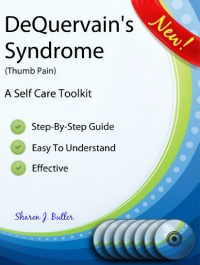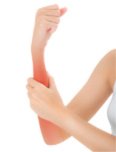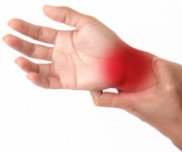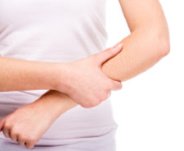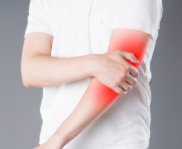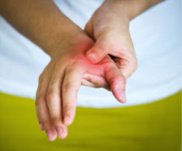DeQuervains Syndrome Self Care
DeQuervains Syndrome self care is especially important for the most effective restoration of the thumbs to a more normal condition. Learning the right kind of stretches that will really help the thumbs and not overwhelm them is a critically important step in recovering from DeQuervains Syndrome. To learn more about what makes a really effective stretch, click here.
2 Helpful Stretches For DeQuervains Syndrome (Thumb Pain)
Here are two stretches that are particularly helpful for reducing or eliminating the symptoms of deQuervains Syndrome.
Stretch #1 stretches the muscle tissue between the thumb and the palm. Because the joint at the base of the thumb is destabilized in almost every case of deQuervains Syndrome, it is very important to relieve the stress on the joint by creating more slack in the tissues that hold the thumb joint in place. Stretching the web of muscle between the thumb and palm is a very good way to do this.
Here's how to do this stretch:
Grasp the full length of the thumb with your other hand and very gently pull the thumb away from the palm. Hold the stretch for about ten seconds, then release and rest your hand on your lap until the residual stretching sensations fade away completely.
Stretch #2 is helpful for stretching the tendon that extends from the thumb, through the wrist and onto the top of the forearm.
Here's how to do this stretch:
Lightly hold your thumb in a soft fist and tilt your fist towards your little finger. Slowly bend at your wrist, moving your fist up and down. You should feel a distinct stretch in the affected tendon with this move. Do this stretch only once per day and for no more than 10 seconds at a time.
If you consistently do these two stretches, then you should feel a significant reduction in your symptoms.
I recommend that you practice these two stretches only once a day to avoid over-stimulating the tiny muscles and tissues associated with the thumbs. Results are cumulative and will build over days of consistent and appropriate practice.
A word of caution...The thumbs have very little muscle tissue associated with them. If you are too aggressive with your stretches, then you stand the chance of irritating those muscles and making the thumb joint feel more sore and painful. If you make such a mistake, and we all do from time to time, then take a full 24 hours to let your thumbs and hands rest before resuming practice of these stretches. Make sure the next time you do the stretches, you do them far more gently.
Because the fascia of the thumbs is part of a large continuum of tissue that travels throughout the entire body, it is important to address the condition of the other tissues that might also be in a direct path with the lines of strain that develop in deQuervains Syndrome. Stretching the entire length of the arm, especially the tissues that surround the biceps muscles in the upper arm, will result in even more stability for the thumb and better overall results of your self care program.
Try to become more conscious of how you hold your thumbs throughout the day. People tend to draw their thumbs closer to the palm when they are exerting too much effort with the thumb, whether a result of hitting computer keys with too much force, or grasping objects too tightly. Try to develop a new habit of opening your hand more fully as you type, grasp, lift and carry. This will help eliminate the destabilized joint at the base of the thumb which is a prevalent symptom in almost all cases of deQuervains Syndrome.
Another important thing is to consume plenty of water each day. If the tissues in the thumb area become too dehydrated, then it becomes harder for the fascia associated with the thumbs to slide and glide as they are designed to do. Water is one of the most effective, low cost solutions that can make it easier to overcome the effects of deQuervains Syndrome.
To learn more about deQuervains Syndrome, visit the following sections:
deQuervains Syndrome Anatomy
deQuervains Syndrome Symptoms
Click the block below that most closely matches your injury for more information and to find the Toolkit we offer to help you in your recovery.
